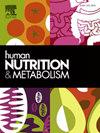Early weaning and anemia in children under 2 years old from indigenous peoples in Alagoas state, Brazil
IF 1.8
Q3 ENDOCRINOLOGY & METABOLISM
引用次数: 0
Abstract
Objectives
To investigate the frequency of breastfeeding (BF) practices and factors associated with early weaning and anemia in indigenous children under 2 years of age.
Study design
A household cross-sectional study was conducted in 13 indigenous communities in Alagoas state, northeastern Brazil.
Methods
Mothers of eligible children were interviewed to gather socioeconomic, demographic, health, and feeding practice data. Blood samples were collected to assess the hemoglobin concentration (Hb). Multiple Cox, linear, and Poisson regression models were employed to examine the factors associated with weaning and anemia (Hb < 110 g/L in children aged 6 months and older).
Results
Of the 1303 households surveyed, 145 had children under 2 years old. The prevalence of exclusive BF at 6 months was only 19 %. High frequencies of anemia (42.5 %), bottle-feeding (70 %), and pacifier use (31 %) were observed. The use of bottle and pacifier was associated with early weaning. Bottle-feeding was significantly associated with anemia (PR = 2.62; 95 % CI: 1.42–4.84) after adjusting for household wealth index.
Conclusions
BF practices among indigenous children do not meet WHO recommendations. The use of artificial nipples was linked to early weaning, and bottle feeding was associated with anemia after 6 months of age. These findings underscore the urgent need for interventions to promote, protect, and support BF in indigenous people, guiding multidisciplinary health teams in properly caring for young children in indigenous communities.
巴西阿拉戈斯州土著居民2岁以下儿童的早期断奶和贫血
目的调查2岁以下土著儿童母乳喂养频率及其与早期断奶和贫血的相关因素。研究设计在巴西东北部阿拉戈斯州的13个土著社区进行了一项家庭横断面研究。方法对符合条件的儿童母亲进行访谈,收集社会经济、人口统计学、健康和喂养实践数据。采集血样评估血红蛋白浓度(Hb)。采用多重Cox、线性和泊松回归模型来检验与断奶和贫血相关的因素(Hb <;6个月及以上儿童110g /L)。结果在调查的1303个家庭中,145个家庭有2岁以下的孩子。6个月纯BF患病率仅为19%。观察到贫血(42.5%)、奶瓶喂养(70%)和安抚奶嘴使用(31%)的高频率。奶瓶和奶嘴的使用与早期断奶有关。奶瓶喂养与贫血显著相关(PR = 2.62;95%置信区间:1.42-4.84)。结论土著儿童的bf做法不符合世卫组织的建议。人工乳头的使用与早期断奶有关,奶瓶喂养与6个月后的贫血有关。这些发现强调了迫切需要采取干预措施,以促进、保护和支持土著人民的BF,指导多学科卫生团队妥善照顾土著社区的幼儿。
本文章由计算机程序翻译,如有差异,请以英文原文为准。
求助全文
约1分钟内获得全文
求助全文
来源期刊

Human Nutrition and Metabolism
Agricultural and Biological Sciences-Food Science
CiteScore
1.50
自引率
0.00%
发文量
30
审稿时长
188 days
 求助内容:
求助内容: 应助结果提醒方式:
应助结果提醒方式:


